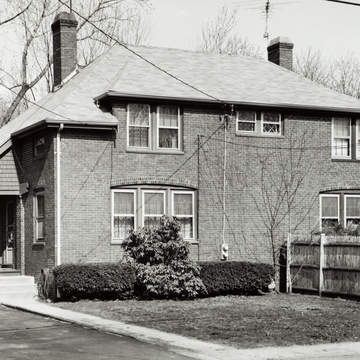Phillipsdale offers a picture of various types of late-nineteenth- and early-twentieth-century workers' housing, much of which is fairly well preserved. The Phillips and Glenlyon operations so overshadowed the brief occupancy of the Richmond Paper Company at this place that some have conjectured that its earliest housing was “moved in” from another site. More likely it went up c. 1883–1884 when Richmond Paper built the factory acquired by
The intersection of Bourne Avenue, where the former Phillips company store, now much altered, occupies the northwest corner, marks the former heart of the village, providing the principal entrance to both the wire works and the bleachery. Beyond this intersection are more brick duplexes derived from enlightened English prototypes, numbers 166–180 and 238–260, these slightly staggered on their sites in another nominal gesture against the regimented look. Opposite, at numbers 167–235, are examples of a type unusual for Rhode Island: a long row of earlier (c. 1883) single-family houses built as squarish boxes, their gable ends to the street with long, narrow porches for both entrance and sitting running the length of their downhill side (except for a few later insertions of two-story flats with tiered porches and more gambreled gables facing the street). A couple of traditional Victorian clapboard duplexes (1883) with ornamental brackets supporting door hoods follow at numbers 253–259. The pyramidal pile of the roof and the poke of tall chimneys through it are especially impressive. Both their size and their position close to the top of the village slope suggest that they housed overseers (probably for the bleachery, because the Phillips superintendent and company doctor shared a duplex next to the company store). A final pair of brick duplexes, numbers 261–267, are larger than the other brick units and prettier, with latticed porches; they, too, were doubtless for supervisory personnel. On Ruth Street, which runs on a ridge above the rest of the village, is more duplex housing of different sorts from different building periods (now intermixed with much more recent houses). Notwithstanding this considerable stock of company housing in the village, most workers originally commuted to the Seekonk enclave by trolley from Providence.




















